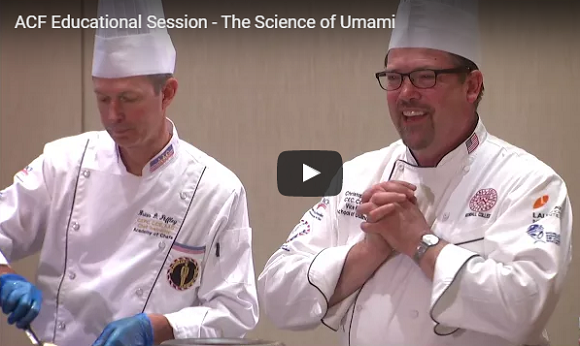
and the Science of Umami
I recently had the pleasure of attending a standing-room only session on umami at the annual meeting of the American Culinary Federation. I will admit to being a bit self-conscious in this room full of culinary experts in their beautiful stiff white chef coats. (I was an inch away from purchasing a coat of my very own at the little stand in the meeting exhibit hall, but somehow it seemed a bit inauthentic. Like wearing a stethoscope at a medical meeting. But I digress…)
Chef Chris Koetke, Vice President at the Culinary Institute at Kendall College, spoke eloquently about the human’s innate drive toward taste and nourishment and the chef’s complimentary drive to meet those needs by delivering good-tasting foods. He explained the fifth taste of umami and how the amino acid glutamate is picked up by receptors on the tongue, sending biological signals of “protein” to our brains. Chef Chris talked about the many sources of glutamate in foods – it’s one of the most abundant amino acids in our bodies and in our foods.
Then the story got more interesting. We learned how foods with high levels of “free” glutamate like aged Parmesan cheese or Serrano ham (versus foods where that amino acid is bound within the protein complex) are the real umami heroes. But the “aha” moment came when he revealed to the group that this “free” glutamate is exactly the same as glutamate that is sprinkled onto food in the form of monosodium glutamate, or MSG. Yep – that got some attention in the room.
“Natural” and MSG
And how is that sprinkle form of glutamate produced? By a natural fermentation process that we’ve used for centuries in food production for beer, wine, bread and other favorite staples. My guess is that most of the folks in the room had not previously used the words “natural” and “MSG” in the same sentence!
So where were we left at the end of the day as we prepared to re-enter our kitchens? (OK – I know I am saying “our” kitchens, but I do recognize that my kitchen is substantially smaller than those of my fellow participants in their beautiful white chef coats.) Chef Chris put it this way: Many ingredients will enhance the umami experience in a dish – soy sauce, Worcestershire sauce, shiitake mushrooms, Parmesan cheese. But all these foods have a unique flavor profile in addition to umami. And if you want those extra favors, fine. But sometimes we just want that nice flavor boost without adding other favors. And that’s where a quick little sprinkle of MSG does the trick.
Now I’m off to eBay to see if I might be able to grab one of those coats at a discount.
Visit “The Science of Umami – Sponsored By: The Glutamate Association” to view the full American Culinary Federation educational session presentation.


